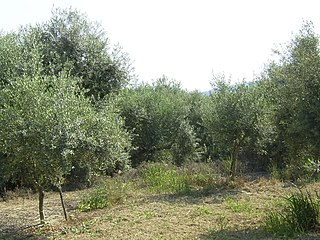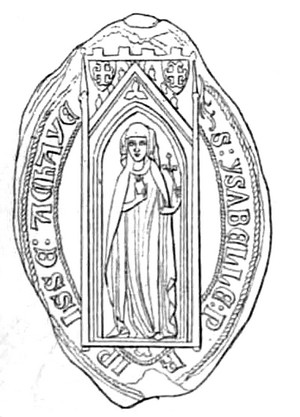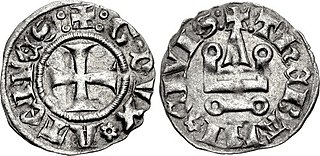Related Research Articles

Photios I, also spelled Photius, was the ecumenical patriarch of Constantinople from 858 to 867 and from 877 to 886. He is recognized in the Eastern Orthodox Church as Saint Photios the Great.

William of Villehardouin was the fourth prince of Achaea in Frankish Greece, from 1246 to 1278. The younger son of Prince Geoffrey I, he held the Barony of Kalamata in fief during the reign of his elder brother Geoffrey II. William ruled Achaea as regent for his brother during Geoffrey's military campaigns against the Greeks of Nicaea, who were the principal enemies of his overlord, the Latin Emperor of Constantinople Baldwin II. William succeeded his childless brother in the summer of 1246. Conflicts between Nicaea and Epirus enabled him to complete the conquest of the Morea in about three years. He captured Monemvasia and built three new fortresses, forcing two previously autonomous tribes, the Tzakones and Melingoi, into submission. He participated in the unsuccessful Egyptian crusade of Louis IX of France, who rewarded him with the right to issue currency in the style of French royal coins.
During the late Middle Ages, the two cities of Argos and Nauplia formed a lordship within the Frankish-ruled Morea in southern Greece.

The Battle of the Olive Grove of Kountouras took place in the summer of 1205, in Messenia in the Morea peninsula, between the Frankish Crusaders and the local Byzantine Greeks, resulting in a victory of the Franks and the collapse of the local resistance.

Florent of Hainaut was Prince of Achaea from 1289 to his death, in right of his wife, Isabella of Villehardouin. He was the son of John I of Avesnes and Adelaide of Holland. From his father he received the stadholdership (government) of Zeeland.

Isabella of Villehardouin was reigning Princess of Achaea from 1289 to 1307. She was the elder daughter of Prince William II of Achaea and of his third wife, Anna Komnene Doukaina, the second daughter of Michael II Komnenos Doukas, the despot of Epiros.

Guy II de la Roche, also known as Guyot or Guidotto, was the Duke of Athens from 1287, the last duke of his family. He succeeded as a minor on the death of his father, William I, at a time when the duchy of Athens had exceeded the Principality of Achaea in wealth, power, and importance.

Glarentza, also known as or Clarenia, Clarence, or Chiarenza, was a medieval town located near the site of modern Kyllini in Elis, at the westernmost point of the Peloponnese peninsula in southern Greece. Founded in the mid-13th century by William II of Villehardouin, the town served as the main port and mint of the Frankish Principality of Achaea, being located next to the Principality's capital, Andravida. Commerce with Italy brought great prosperity, but the town began to decline in the early 15th century as the Principality itself declined. In 1428, Glarentza was ceded to the Byzantine Despotate of the Morea, and served as its co-capital, being the residence of one of the Palaiologos despots, until the Ottoman conquest in 1460. Under Ottoman rule, Glarentza declined rapidly as the commercial links with Italy were broken, and by the 16th century was abandoned and falling into ruin. Little remains of the town today: traces of the city wall, of a church and a few other buildings, as well as the silted-up harbour.
George I Ghisi was a Latin feudal lord in medieval Greece.
John Chauderon was the Baron of Estamira and Grand Constable of the Principality of Achaea, the strongest of the principalities of Frankish Greece.

The Barony of Karytaina or of Skorta was a medieval Frankish fiefdom of the Principality of Achaea, located in the Peloponnese peninsula in Greece, centred on the town of Karytaina in the mountainous region known as Skorta.
Vilain of Aulnay was a French knight from Aulnay-l'Aître in the Champagne who became marshal of the Latin Empire of Constantinople and first Baron of Arcadia in the Principality of Achaea. In the Greek version of the Chronicle of the Morea, he is attested as Βηλὲς ντὲ Ἀνόε, a form which passed to the other versions of the Chronicle as Anoé, Annoée or Anoée.

Richard Orsini was the count palatine of Cephalonia and Zakynthos from before 1260 to his death in 1303/4, and also Count of Gravina in 1284–91. He also served on behalf of the Angevin Kingdom of Naples as captain-general of Corfu in 1286–90 and as the bailli in the Principality of Achaea from 1297 to 1300. He assisted the Despot of Epirus in battle against the Byzantine Empire, and secured the marriage of his son, John I, to the Epirote ruler's daughter, which would lead in 1318 to the Orsini takeover of Epirus.

John I Orsini was the count palatine of Cephalonia and Zakynthos from 1303 or 1304 to his death in 1317. Married to an Epirote princess, John spent a decade at the Epirote court before succeeding his father, Richard Orsini, as count palatine. As a vassal of the Principality of Achaea, he was involved in its domestic affairs and especially the dynastic dispute between the infante Ferdinand of Majorca and Princess Matilda of Hainaut in 1315–16, and participated in a number of Latin campaigns against Epirus, which he aspired to rule. A year after his death, his son and heir Nicholas Orsini seized Epirus and brought it under the Orsini family's rule.
Andronikos Asen Zaccaria de Damala or Asanes was a Genoese lord of the Principality of Achaea in southern Greece.
William de la Roche was a Baron of Veligosti and Damala in the Principality of Achaea, and a relative of the ruling Dukes of Athens of the de la Roche family.
Engilbert of Liederkerque was a Flemish knight who, along with his younger brother Walter, accompanied their uncle Florent of Hainaut to the Peloponnese (Morea) in southern Greece, following Florent's proclamation as Prince of Achaea in 1289. There, Engilbert married a daughter of Richard Orsini, Count palatine of Cephalonia and Zakynthos. In 1294, after the death of John Chauderon, who was his brother-in-law, Engilbert succeeded him as Grand Constable of Achaea.
John of Durnay was the Baron of Gritzena in the Principality of Achaea in the late 1280s and early 1290s.

Photios Kalpidis or Photios of Korytsa was the Greek Orthodox metropolitan bishop of Korçë, Ottoman Empire, from 1902 to 1906. He was assassinated in 1906 by irregular bands due to his pro-Greek activity. Photios was proclaimed an "ethnomartyr" by the Church of Greece.
Benjamin of Kalamata was the longtime chancellor of the Principality of Achaea in Frankish Greece from 1297 until at least 1324.